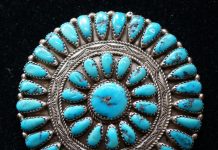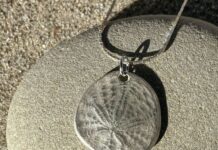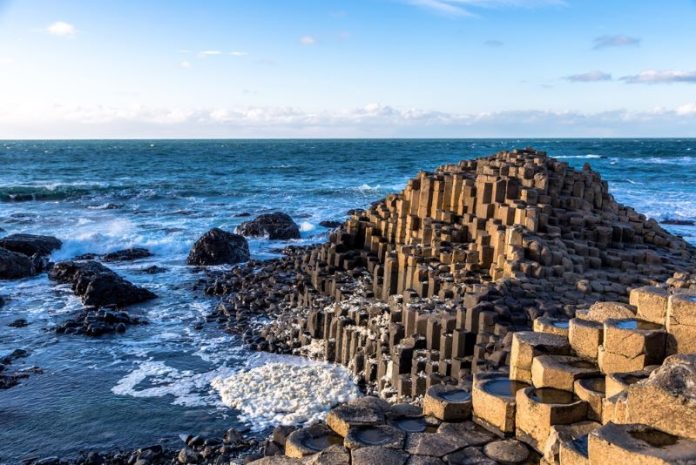
The Giant’s Causeway and the Scottish Isle of Staffa is a visitor hotspot and provides the stuff of legends. The Irish are also known for telling great stories, be they of leprechauns, fairies or giants. Let’s explore the facts and fiction surrounding the legend of Finn McCool and the magnificent basalt structures that make up a stairway of basalt columns that stretch into the sea all the way to Scotland.
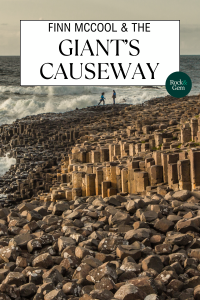
The Legend
There are more versions of this story than there are ways to spell Finn McCool…Fin MacCool…Fionn MacCumhaill…Fion macCumhal. Here is just one of those tales.
There were two rival giants, Finn McCool from Ireland and Benandonner, from Scotland. Finn decided to build a bridge to the nearby coast of Scotland to get a look at his opponent before challenging him to a fight. He completed the causeway in just two days and quickly crossed over to Scotland for a peek at the Scottish giant.
After discovering that Benandonner was much larger than he imagined, Finn returned home to ask the advice of his wife, Oonagh, even as he could hear Benandonner’s heavy footfalls following right behind him. Oonagh quickly came up with a plan. She dressed Finn like a baby and put him in a huge cradle by the fireplace.
Oonagh Cooks up a Plan
When the Scottish giant knocked on Finn and Oonagh’s door, Finn pretended to sleep in the cradle while Oonagh invited Benandonner into her home. She explained that Finn had gone hunting in a nearby county and that she was making his favorite meal of griddlecakes for his return.
Now, some of the cakes Oonagh made contained chunks of the griddle iron while others did not—all part of her plan. She offered one of the iron-laced cakes to Benandonner and when he took a bite of it, he broke a tooth. She apologized and asked if he would like to see their baby who was sleeping in the other room as she wanted to give the infant one of the cakes as well. Of course, the cake that Oonagh took to the baby (Finn) had no iron in it and the baby ate it with no problem.
When Benandonner saw the size of the infant, he was filled with fear of just how large Finn might be if his child was so big and how strong he might be if his baby could eat the tough griddlecakes with ease.
The Scottish giant quickly returned home to the Isle of Staffa and is said to have thrown a chunk of the causeway back across the sea creating the Isle of Man. Finn destroyed the remaining bridge he had built to Scotland. And everyone lived happily ever after.
Fun Facts
It may be fun to point out a few flaws in this story.
First, the distance, on a straight line from the Giant’s Causeway to Fingal’s Cave on the Isle of Staffa, where Benandonner supposedly lived, is approximately 82 miles. That straight line crosses two pieces of mainland Scotland before reaching Fingal’s cave. A long walk for either giant.
Also, the Isle of Man is located in the Irish Sea, approximately 162 miles from either of the locations in the story—more than a stone’s throw away!
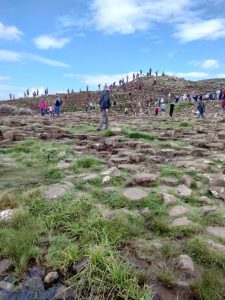
How Do Columns Form?
Both the Giant’s Causeway and Fingal’s Cave on the Isle of Staffa, are made up of basalt columns that formed 50 to 60 million years ago during a volcanic period when cooling lava contracted and fractured into regular hexagonal patterns perpendicular to the cooling surface.
Basalt is an igneous rock, low in silica, but rich in iron and magnesium. It is formed deep inside the earth and is spread on the surface as molten lava. The rate at which the lava cools determines the rock structure. Not all basalt forms into columns, only when the conditions are right.
Under those perfect conditions, as the lava cools, it starts to shrink and the surface starts to crack. If the parts of the lava that start cooling first are evenly spaced, forces pull inward toward the coolest spots and create chunks that are mostly hexagonal. Although the description of the basalt columns says they are hexagonal, a closer look shows that some columns have four, five, seven or even eight sides—not always six.
The more uniform the lava, the more uniform the columns. The columns form because of the quick cooling lava. Some scientists believe that this process is accelerated by the presence of water.
Not all Columns are Created Equal
Columns form from the top down and as lower levels cool, they are pulled into this same columnar structure. Columns can vary in size from as large as nine feet to smaller than an inch in diameter and as high as 90 feet tall. If they form straight and parallel, they are called colonnades, like those present at the Giant’s Causeway and Fingal’s Cave. In other locations, they can be pushed and morphed into a structure called entablature, abstract or irregular zones or tiers of jointed columns.
Basalt structures can be found all over the world, even as close to home as the Devil’s Postpile National Monument in California. Scientists have even found them as far away as Mars. But let’s take a closer look at the columns that make up each of our giant’s homes in this Irish tale.
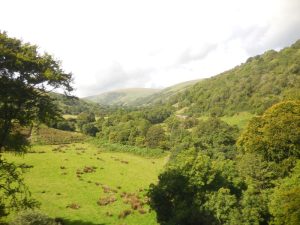
The Giant’s Causeway
A UNESCO World Heritage Site since 1986, the Giant’s Causeway is managed by the British National Trust. The site can be visited free of charge if you choose to walk both directions from the parking area at the top of the nearly 300-foot cliff.
There is a fee to enter the new Visitors’ Center, completed in 2012, as well as to ride the motorized tram that takes visitors down the cliff to the sea. Tickets for each can be purchased separately, including one-way or two-way tram tickets.
A Natural Wonder
Nearly one million tourists a year visit this site which is considered to be one of the natural wonders of the world. The Giant’s Causeway is made up of approximately 40,000 interlocking basalt columns, covering an area of almost 173 acres. On a busy day, the basalt pedestals ranging up to 40 feet high, can be covered with tourists scampering over them like a playground for adults. Of course, these stepping stones are fun for the young ones as well.
If You Go
The summer months are most popular for tourists, so a visit in early spring or late fall is recommended to avoid crowds. When I visited, on a busy day in August of 2023, the queue to ride the motorized tram was upwards of 45 minutes in both directions. When you stand back and survey the entire causeway, it is easy to imagine a giant scampering down the cliff and into the sea as he steps from column to column—just like the tourists.

Photo courtesy Love Scotland Page, Facebook
Fingal’s Cave – Isle of Staffa
Staffa (old Norse, meaning pillar island) is an uninhabited island just off the main coast of Scotland. It too has a basalt column structure protected and managed by the British National Trust since 1986. Although not as popular as the Giant’s Causeway, about 100,000 tourists visit Fingal’s Cave every year.
A curious fact is that Fingal’s Cave got its name from Finn McCool rather than Benandonner who was thought to reside here. The name means “white stranger.” It opens directly to the ocean and is made up of basalt columns, some as high as 72 feet tall. The cave is 270 feet deep and 40 feet wide. The island which covers about 82 acres, is almost entirely made up of basalt columns.
The cave is said to have perfect natural acoustics. The sounds of the water in the cave may have inspired German Composer Felix Mendelssohn to write his famous Hebrides Overture after a visit to Fingal’s Cave in 1829. Other famous visitors to this cave include Queen Victoria and Jules Verne.
Giant’s Causeway: What to Expect If You Go
Boats no longer are allowed to enter the cave, but on calm days, visitors can step off onto the basalt stones and, just like at the Giant’s Causeway, use the stones to step their way into this beautiful structure.
Improvements are in progress to protect the environment and the wildlife of Staffa. Many tourists visit Staffa to see the puffins. A dock area and pathways have been constructed to accommodate the increasing number of visitors and protect the island from erosion.
Private tours can be arranged to visit Fingal’s Cave from Oban, on the mainland of Scotland or from several ports on the Isle of Mull. The boat ride takes about 45 minutes. The tours can be physically challenging, so be sure to consider your limitations before going.
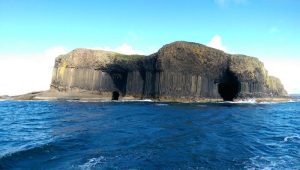
Photo courtesy TripAdvisor
Fact or Fiction: Time to Decide
You may think that the legend of the Giant’s Causeway is just a child’s fairytale, or something made up by an Irishman returning home late from the pub, but a variety of these stories are available in children’s books. As some of us celebrate all things Irish this March, you may want to share one of these books with a young rockhound in your life. The bedtime story can then be followed by a real lesson in the geology of basalt columns and the Giant’s Causeway. What a great way to pass on your love of rocks.
Sue Eyre is a retired employee benefits supervisor with a passion for travel, photography and mineral collection. She studied Journalism and Accounting at the University of Wisconsin-Milwaukee. She is a 20-year member of the Wisconsin Geological Society and a regular contributor to the club’s monthly newsletter, The Trilobite.
This article about the legend of Finn McCool and the Giant’s Causeway previously appeared in Rock & Gem magazine. Story by Sue Eyre. Click here to subscribe.



